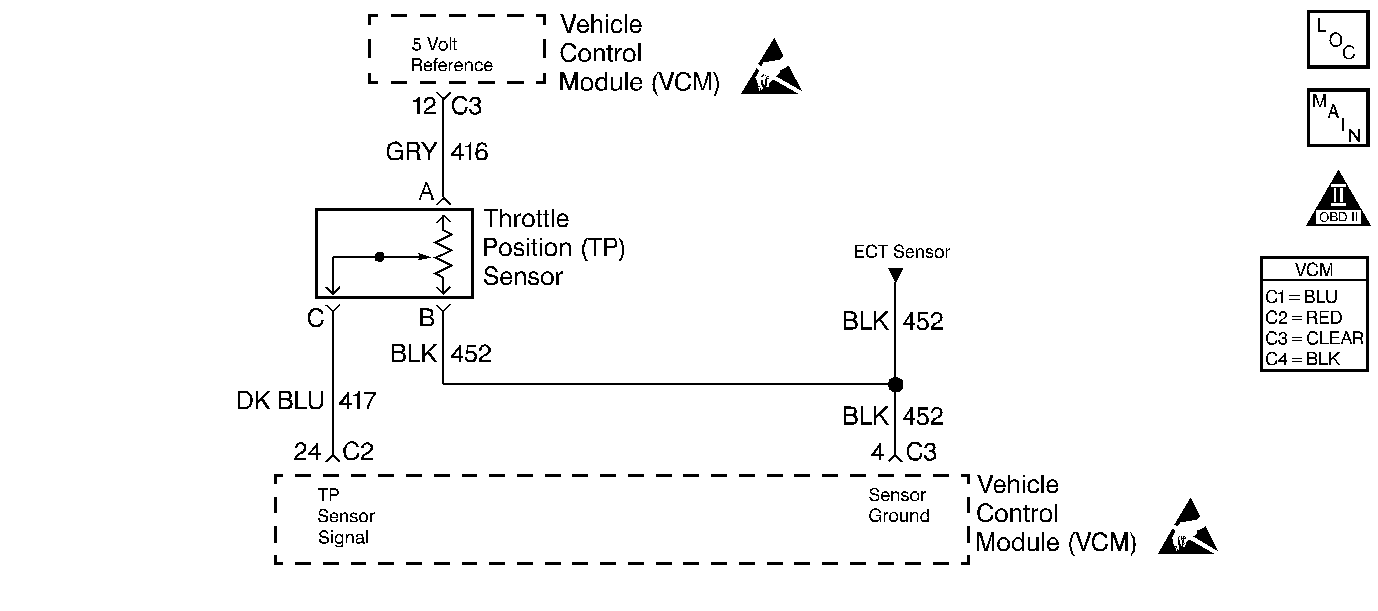
Circuit Description
The Throttle Position (TP) sensor provides a voltage signal which changes relative to the throttle blade angle. The signal voltage varies from about 0.5 volt at idle to about 4.0 volts at Wide Open Throttle (WOT).
The VCM uses the TP signal, one of the most important inputs, for fuel control and for most of the VCM control outputs.
Each time the voltage drops below 1.25 volts and stops, the VCM assumes this value as the 0 throttle angle, and the VCM measures the percent throttle from this point on. The DTC P0123 is a type A DTC. The DTC P1122 is a type D DTC.
Conditions for Setting the DTC
The DTC will set under the following conditions:
| • | The engine is running |
| • | The Throttle Position (TP) sensor signal is greater than 4.9 volts |
Action Taken When the DTC Sets
Important: The scan tool will not indicate default values.
When the P0123 is reported and 1 failure has occurred, the VCM sets the DTC P0123, and the VCM turns ON the MIL.
Conditions for Clearing the MIL/DTC
The VCM turns OFF the MIL after 3 consecutive driving trips without a fault condition present. A history DTC will clear if no fault conditions have been detected for 40 warm-up cycles (the coolant temperature has risen 22°C (40°F) from the start-up coolant temperature and the engine coolant temperature exceeds 71°C (160°F) during that same ignition cycle) or the scan tool clearing feature has been used.
Diagnostic Aids
The scan tool reads the throttle position in volts. The scan tool should read about 0.45 to 0.85 volt with the throttle closed and the ignition switch turned ON or at idle. The voltage should increase at a steady rate as the throttle is moved toward the Wide Open Throttle (WOT).
Also, some scan tools will read the throttle angle. 0 % = closed throttle. 100 % = WOT.
Scan the TP sensor while depressing the accelerator pedal with the engine turned off and the ignition turned on. The display should vary from below the 1.25 volts (1250 mV) when the throttle was closed to over 4.5 volts (4500 mV) when the throttle is held at WOT position.
This DTC will result if the TP ground circuit is open or the TP signal circuit is shorted to the voltage.
Refer to the Intermittent Conditions .
Test Description
The numbers below refer to the step numbers in the diagnostic table.
-
If the TP signal measures greater than 4.8 volts, then the fault exists.
-
With the TP sensor disconnected and if the VCM and the wiring are okay, the TP signal should go low.
-
Probing the TP ground circuit with a test lamp checks the 5.0 volt return circuit. This step isolated a faulty sensor, the VCM or an open TP ground circuit.
Step | Action | Value(s) | Yes | No |
|---|---|---|---|---|
1 |
Important: Before clearing the DTCs use the scan tool in order to record the freeze frame and the failure records for reference because the Clear Info function will lose the data. Was the Powertrain On-Board Diagnostic (OBD) System Check performed? | -- | ||
Does the scan tool display a TP sensor signal greater than the specified value? | 4.8 V | |||
Does the scan tool display a TP sensor signal less than the specified value? | 0.2 V | |||
The DTC is intermittent. If no additional DTCs are stored, refer to the Diagnostic Aids. If additional DTCs are stored, refer to those tables first. Are any additional DTCs stored? | -- | Go to The Applicable DTC Table | -- | |
5 | With a DVM connected to ground, probe the 5V reference circuit (at the TP sensor electrical connector). Is the voltage greater than the specified value? | 5.2V | ||
6 | Probe the TP sensor ground circuit ( at the TP sensor connector) with a test light connected to B+. Is the test lamp on? | -- | ||
7 | Replace the TP sensor. Refer to TP Sensor Replacement . Is the action complete? | -- | -- | |
8 | Check for a short to voltage in the TP sensor signal circuit. Was a problem found | -- | ||
9 |
Is the voltage greater than the specified value? | 5.2V | ||
10 | With a DVM connected to ground, measure the voltage on the VCM connector terminal GR27. Is the voltage greater than the specifed value? | 5.2V | ||
11 |
Is the voltage greater than the specified value? | 5.2V | ||
12 | Repair the short to voltage on the 5V reference circuit. Refer to Wiring Repairs in Engine Electrical. Is the action complete? | -- | -- | |
13 | Check the sensor ground circuit for an open. Was a problem found? | -- | ||
14 | Repair as necessary. Refer to Wiring Repairs in Engine Electrical. Is the action complete? | -- | -- | |
15 | Replace the EGR valve. Refer to EGR Valve Replacement for the 4.3L. Is the action complete? | -- | -- | |
16 | Repair the short to voltage on the 5V reference circuit (terminal GR27). Is the action complete? | -- | -- | |
17 | Replace the VCM. Important: If the VCM is faulty, reprogram the VCM. Refer to VCM Replacement/Programming . Is the replacement complete? | -- | -- | |
18 |
Does the scan tool indicate that this diagnostic ran and passed? | -- | ||
19 | Using the scan tool, select the Capture Info and Review Info. Are any DTCs displayed that have not been diagnosed | -- | Go to The Applicable DTC Table | System OK |
